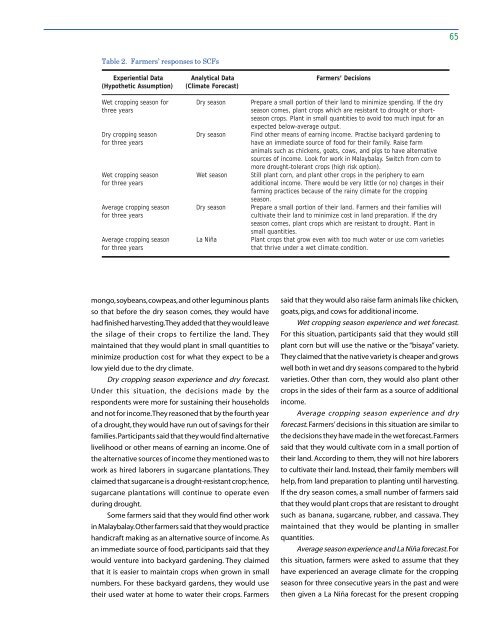Read More - Philippine Institute for Development Studies
Read More - Philippine Institute for Development Studies
Read More - Philippine Institute for Development Studies
You also want an ePaper? Increase the reach of your titles
YUMPU automatically turns print PDFs into web optimized ePapers that Google loves.
65<br />
Table 2. Farmers’ responses to SCFs<br />
Experiential Data Analytical Data Farmers’ Decisions<br />
(Hypothetic Assumption) (Climate Forecast)<br />
Wet cropping season <strong>for</strong> Dry season Prepare a small portion of their land to minimize spending. If the dry<br />
three years<br />
season comes, plant crops which are resistant to drought or shortseason<br />
crops. Plant in small quantities to avoid too much input <strong>for</strong> an<br />
expected below-average output.<br />
Dry cropping season Dry season Find other means of earning income. Practise backyard gardening to<br />
<strong>for</strong> three years<br />
have an immediate source of food <strong>for</strong> their family. Raise farm<br />
animals such as chickens, goats, cows, and pigs to have alternative<br />
sources of income. Look <strong>for</strong> work in Malaybalay. Switch from corn to<br />
more drought-tolerant crops (high risk option).<br />
Wet cropping season Wet season Still plant corn, and plant other crops in the periphery to earn<br />
<strong>for</strong> three years<br />
additional income. There would be very little (or no) changes in their<br />
farming practices because of the rainy climate <strong>for</strong> the cropping<br />
season.<br />
Average cropping season Dry season Prepare a small portion of their land. Farmers and their families will<br />
<strong>for</strong> three years<br />
cultivate their land to minimize cost in land preparation. If the dry<br />
season comes, plant crops which are resistant to drought. Plant in<br />
small quantities.<br />
Average cropping season La Niña Plant crops that grow even with too much water or use corn varieties<br />
<strong>for</strong> three years<br />
that thrive under a wet climate condition.<br />
mongo, soybeans, cowpeas, and other leguminous plants<br />
so that be<strong>for</strong>e the dry season comes, they would have<br />
had finished harvesting. They added that they would leave<br />
the silage of their crops to fertilize the land. They<br />
maintained that they would plant in small quantities to<br />
minimize production cost <strong>for</strong> what they expect to be a<br />
low yield due to the dry climate.<br />
Dry cropping season experience and dry <strong>for</strong>ecast.<br />
Under this situation, the decisions made by the<br />
respondents were more <strong>for</strong> sustaining their households<br />
and not <strong>for</strong> income. They reasoned that by the fourth year<br />
of a drought, they would have run out of savings <strong>for</strong> their<br />
families. Participants said that they would find alternative<br />
livelihood or other means of earning an income. One of<br />
the alternative sources of income they mentioned was to<br />
work as hired laborers in sugarcane plantations. They<br />
claimed that sugarcane is a drought-resistant crop; hence,<br />
sugarcane plantations will continue to operate even<br />
during drought.<br />
Some farmers said that they would find other work<br />
in Malaybalay. Other farmers said that they would practice<br />
handicraft making as an alternative source of income. As<br />
an immediate source of food, participants said that they<br />
would venture into backyard gardening. They claimed<br />
that it is easier to maintain crops when grown in small<br />
numbers. For these backyard gardens, they would use<br />
their used water at home to water their crops. Farmers<br />
said that they would also raise farm animals like chicken,<br />
goats, pigs, and cows <strong>for</strong> additional income.<br />
Wet cropping season experience and wet <strong>for</strong>ecast.<br />
For this situation, participants said that they would still<br />
plant corn but will use the native or the “bisaya” variety.<br />
They claimed that the native variety is cheaper and grows<br />
well both in wet and dry seasons compared to the hybrid<br />
varieties. Other than corn, they would also plant other<br />
crops in the sides of their farm as a source of additional<br />
income.<br />
Average cropping season experience and dry<br />
<strong>for</strong>ecast. Farmers’ decisions in this situation are similar to<br />
the decisions they have made in the wet <strong>for</strong>ecast. Farmers<br />
said that they would cultivate corn in a small portion of<br />
their land. According to them, they will not hire laborers<br />
to cultivate their land. Instead, their family members will<br />
help, from land preparation to planting until harvesting.<br />
If the dry season comes, a small number of farmers said<br />
that they would plant crops that are resistant to drought<br />
such as banana, sugarcane, rubber, and cassava. They<br />
maintained that they would be planting in smaller<br />
quantities.<br />
Average season experience and La Niña <strong>for</strong>ecast. For<br />
this situation, farmers were asked to assume that they<br />
have experienced an average climate <strong>for</strong> the cropping<br />
season <strong>for</strong> three consecutive years in the past and were<br />
then given a La Niña <strong>for</strong>ecast <strong>for</strong> the present cropping










